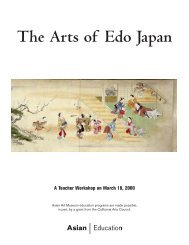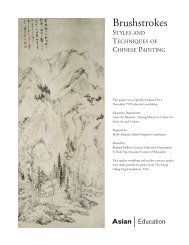Sacred Arts of Tibet (.pdf) - Asian Art Museum | Education
Sacred Arts of Tibet (.pdf) - Asian Art Museum | Education
Sacred Arts of Tibet (.pdf) - Asian Art Museum | Education
You also want an ePaper? Increase the reach of your titles
YUMPU automatically turns print PDFs into web optimized ePapers that Google loves.
<strong>Sacred</strong> <strong><strong>Art</strong>s</strong> <strong>of</strong> <strong>Tibet</strong><br />
How did this ancient text come to San Francisco?<br />
According to the donors this manuscript was given to the famous Indian teacher Atisa by a <strong>Tibet</strong>an<br />
named Rinchen Zangbo (958-1055) <strong>of</strong> Western <strong>Tibet</strong>. Atisa left it at the Shalu Monastery, located southeast<br />
<strong>of</strong> Shigatse in southern <strong>Tibet</strong>. When China invaded <strong>Tibet</strong> in 1959, only two monks from Shalu<br />
escaped and they took the manuscript with them. In 1958 it was given to the donor, Mr. Tamang, who<br />
was a monk at the time. After he emigrated to the US, he donated the text to the <strong>Museum</strong> so that it<br />
could be preserved and enjoyed by others.<br />
What is the U-chen script?<br />
The <strong>Tibet</strong>an language is spoken in <strong>Tibet</strong>, Bhutan, Nepal and in parts <strong>of</strong> northern India including Sikkim.<br />
There are two principle forms <strong>of</strong> <strong>Tibet</strong>an writing, U-chen and U-me. U-chen is a printed form used traditionally<br />
in carved wood blocks, and now for computer fonts. U-me scripts are cursive scripts used for <strong>of</strong>ficial<br />
documents and personal letters. While U-chen has one basic form, there are a large variety <strong>of</strong> U-me<br />
scripts, some being very different and quite obscure. Although <strong>Tibet</strong>an belongs to the <strong>Tibet</strong>o-Burman<br />
language group, the U-chen script was modeled on a ancient Sanskritic alphabet known in sixth- and<br />
seventh-century India. <strong>Tibet</strong>ans developed their writing system, which is an alphabet like Hebrew and<br />
Roman script as opposed to a pictographic script like Chinese, in around the seventh century. It is said<br />
this was done in order to be able to translate Buddhist texts into <strong>Tibet</strong>an. The <strong>Tibet</strong>an Emperor Songtsen<br />
Gampo (died 650 CE) sent a delegation to India led by Thonmi Sambhota. After studying the Indian<br />
writing system, Thonmi Sambhota adapted the script for <strong>Tibet</strong>an based on that Indian alphabet.<br />
It consists <strong>of</strong> thirty basic letters, including the vowel a, and four extra vowel sounds on the Indian model<br />
for i, u, e, and o. Spoken <strong>Tibet</strong>an has changed over the centuries but the writing system has not, so written<br />
and spoken <strong>Tibet</strong>an are quite different. For example the word for “eight” is written as brgyad but is<br />
pronounced “gyay”, or the name <strong>of</strong> <strong>Tibet</strong>’s great Emperor Songtsen Gampo would be literally transliterated<br />
into written English as Srong-btsan-sgam-po. This presents a challenge to those who wish to speak<br />
<strong>Tibet</strong>an as a foreign language, but it is advantageous to scholars who want to read ancient texts. Once<br />
they learn to read <strong>Tibet</strong>an, they have access to <strong>Tibet</strong>an texts <strong>of</strong> any time period. <strong>Tibet</strong>an is a monosyllabic<br />
language, meaning that every syllable has a meaning. The extra letters, while not pronounced, are essential<br />
to distinguishing the meaning <strong>of</strong> the written word. (Snellgrove, p. 75)<br />
Discussion Points/Teaching Suggestions<br />
1) Explore the written and spoken <strong>Tibet</strong>an language (see examples on next page). Use travel guides on<br />
<strong>Tibet</strong>, e.g. Lonely Planet or search online:<br />
www.dharma-haven.org/tibetan/language.htm www.geocities.com/Athens/Academy/9594/tibet.htnl<br />
Source<br />
Alex Wayman, trans., Chanting the Names <strong>of</strong> Manjusri (Boston & London: Shambala, 1985): 94-5.<br />
44<br />
<strong>Asian</strong> <strong>Art</strong> <strong>Museum</strong>
















